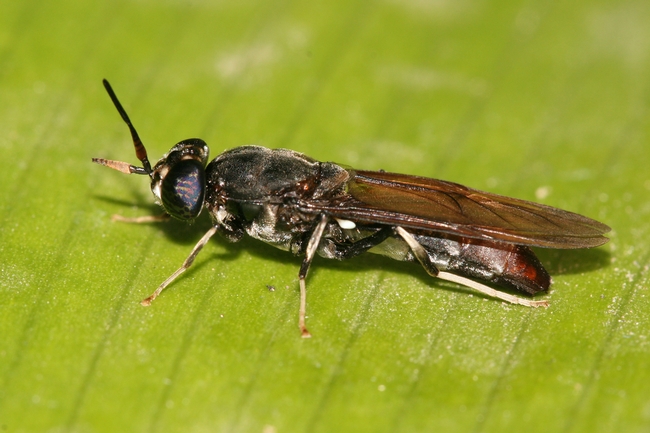Two years ago, overwhelmed by carpets of wormy, windfall apples I resorted to tossing them into a large plastic stock tank that had numerous holes in its sides, remnants of its original purpose - a crawdad washing device.
However, after a couple of weeks I needed the container and on tipping it over was astounded (and a bit revolted) to find that the bottom contained layers of hundreds of larvae. They were dark, grayish brown. I had not been aware of pest flies in the area, and there was no odor, but the huge numbers of larvae present gave me cause for concern. Research showed that I had just made my acquaintance with Black Soldier Fly larvae, Hermetia illucens, a species that efficiently breaks down organic material, especially the green (high nitrogen) matter in decomposing plant materials, and are considered to beneficial.
The adult flies are about 3/4” long, and are shiny black, looking more like a wasp than a house fly. However, these are not a pest or nuisance fly since they have no functioning mouth parts and therefore cannot bite, nor do they have a stinging mechanism. They flit about the garden, intent on their sole purpose; finding suitable sites for laying eggs which are deposited in batches of 600-800 at a time. There are far fewer nuisance flies around when Black Soldier Flies are present since the soldier flies devour the larvae of other species, and it has also been noted that significant reductions in levels of E. coli and salmonella are present in chicken manure when it has been processed by Black Soldier Fly larvae.
They like warm, moist conditions (e.g. rotting apples), and when the larvae hatch they feed voraciously on pretty much anything so long as those conditions are met; kitchen waste (they love coffee grounds), animal manure and carcasses, deserted bees' nests, and even dead fish as seen in this video: https://www.youtube.com/watch?v=DhR2jDS2IJI . The larvae are a pale beige with darker rings around the body segments, but as they mature they become a dark grayish brown. They can eat twice their body weight daily and soon convert kitchen vegetable waste into little fat bodies containing up to 43% protein and 35% fat. This makes them ideal food for chickens, and many chicken keepers farm them for this purpose. The larvae are also dried and used as food for exotic pets and fish. As they prepare to pupate, they tend to move upwards in order to leave their wet environment, searching for drier debris or soil until they mature as flies. This trait is put to good use since the mature larvae can easily be collected as they migrate out of their initial food source.
They do have a downside in some situations. Unfortunately, although Black Soldier Fly larvae and red worms both like the same food, the fly larvae are extremely active, like warm, moist conditions, and tend to make the soil acidic which is not good for worms, so if you have worm bins it is prudent to check them from time to time and remove any Black Soldier Fly larvae that may be present.
The frass that black soldier flies produce makes a clean, odor-free compost, but in my experience the food conversion into the body of the insect is so efficient, there is not a great volume of compost remaining! Dried larvae may also be pulverized and used as fertilizer.
For further reading on this subject:
https://en.wikipedia.org/wiki/Hermetia_illucens
